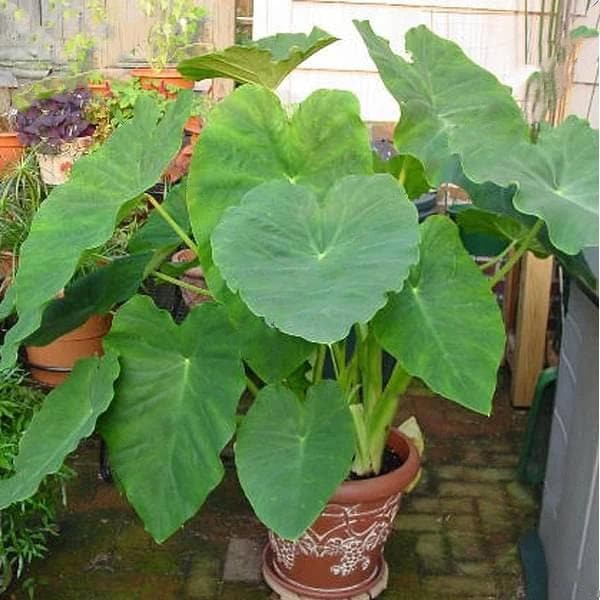
Alocasia, Elephant Ear (Green) - Plant
(MRP Inclusive of all taxes)
- Shipping ₹79 for entire order
- Dispatch in 7 days
- Country of origin: India

(MRP Inclusive of all taxes)
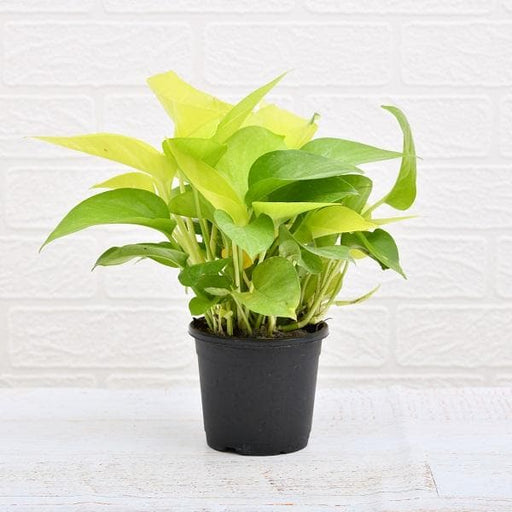 Save 29%
Save 29%
Air Purifier Money Plant with Pot The Air Purifier Money Plant, also known as Pothos or Epipremnum aureum, is a stunning indoor plant that...
View full details
 Save up to 15%
Save up to 15%
Peace Lily, Spathiphyllum - Plant The Peace Lily, scientifically known as Spathiphyllum, is a stunning houseplant celebrated for its elegant white...
View full details
 Save 25%
Save 25%
Jasminum sambac, Mogra, Arabian Jasmine - Plant Jasminum sambac, commonly known as Mogra or Arabian Jasmine, is a fragrant flowering plant...
View full details
 Save 18%
Save 18%
Combo Constituents Includes the Parijat Tree (Night-Flowering Jasmine), a culturally significant plant with fragrant flowers. Description The Pari...
View full details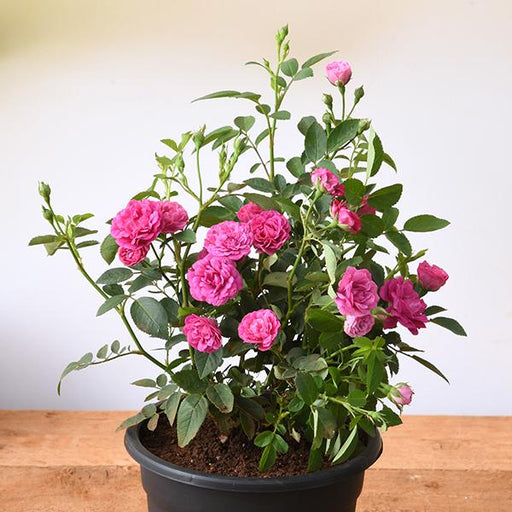
 Save 25%
Save 25%
Miniature Rose, Button Rose (Any Color) - Plant The Miniature Rose, also known as the Button Rose, is a charming and compact flowering plant that ...
View full details Save 25%
Save 25%
Damascus Rose, Scented Rose (Any Color) - Plant The Damascus Rose, also known as Rosa damascena, is a timeless symbol of beauty and romanc...
View full details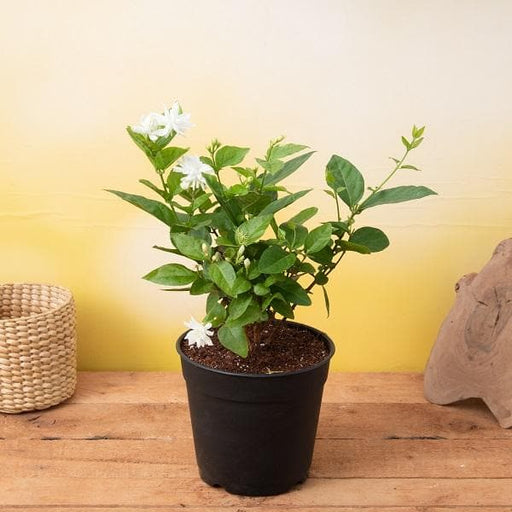
 Save 17%
Save 17%
Beautiful Fragrant Mogra, Arabian Jasmine Plant with Pot The Beautiful Fragrant Mogra, also known as Arabian Jasmine (Jasminum sambac), is...
View full details Save 15%
Save 15%
Pack of Vermicompost and Neem Cake for House Plants Transform your indoor garden with our premium Pack of Vermicompost and Neem Cake, spec...
View full details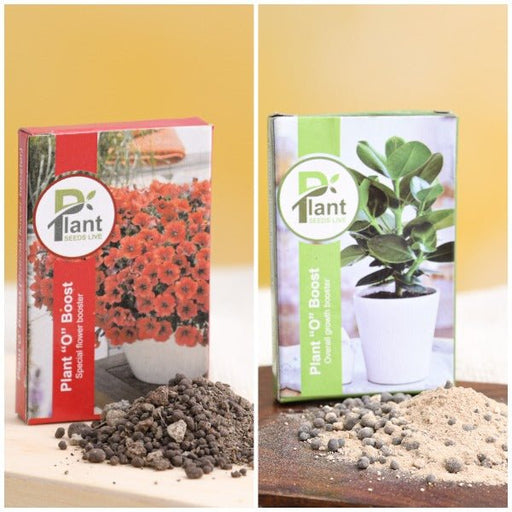
Pack of Plant Growth and Flower Boosters Unlock the full potential of your garden with our Pack of Plant Growth and Flower Boosters! This ...
View full details Save 38%
Save 38%
Combo of Jeevamrut and Neem Raksha for Easy Growth and Protection of Houseplants Transform your indoor garden with our exclusive combo of ...
View full details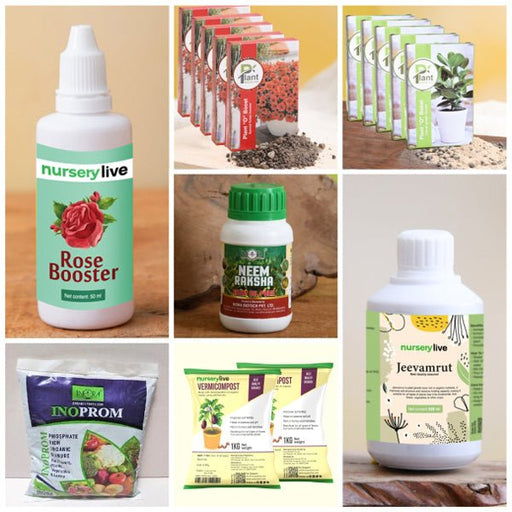 Save 22%
Save 22%
Plant Nutrients Kit (Pack of 16) for a Healthy Garden Transform your garden into a lush paradise with our Plant Nutrients Kit, featuring 1...
View full details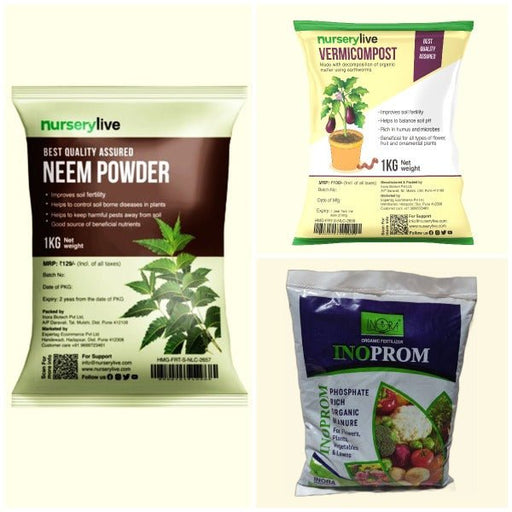 Save 16%
Save 16%
Combo of Top Plant Fertilizers Elevate your gardening game with our exclusive Combo of Top Plant Fertilizers, featuring two bags of premiu...
View full details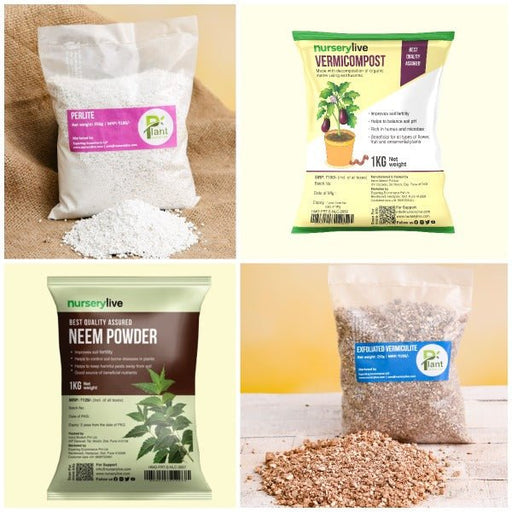 Save 24%
Save 24%
Pack of 4 Additives to Make Soil Healthy and Nutrient Rich Transform your garden into a thriving ecosystem with our Pack of 4 Additives de...
View full details Save 30%
Save 30%
Transform your gardening experience with our premium Combo of Perlite and Vermiculite. This unique blend is designed to enhance soil aeration and ...
View full details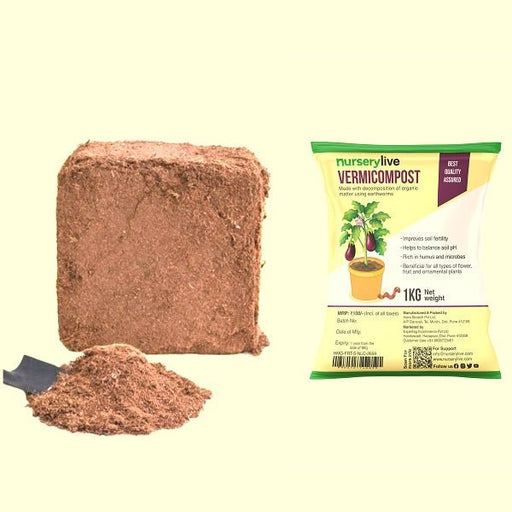 Save 27%
Save 27%
Combo of 2 Vermicompost and Cocopeat - Enrich Your Soil Naturally! Transform your garden into a thriving ecosystem with our Combo of 2 Ver...
View full details
 Save 35%
Save 35%
Best 6 Plants for Perfect Indoor Garden Transform your living space into a lush oasis with our curated collection of the Best 6 Plants for a...
View full details
 Save up to 50%
Save up to 50%
Mini Succulent Garden Pack Transform your space with our Mini Succulent Garden Pack, featuring a delightful collection of 4 any variety beautiful s...
View full details
 Save 30%
Save 30%
5 Best Fragrant Plants Transform your garden or indoor space into a fragrant paradise with our curated selection of the 5 Best Fragrant Plants. Th...
View full details
 Save 24%
Save 24%
Set of 2 Bonsai Looking Grafted Adeniums Transform your indoor or outdoor space with our exquisite Set of 2 Bonsai Looking Grafted Adenium...
View full details Save 45%
Save 45%
Top 4 Die Hard Succulents Pack Transform your indoor or outdoor space with our Top 4 Die Hard Succulents Pack, featuring a curated selecti...
View full details
 Save 30%
Save 30%
5 Best Indoor Plants Pack Transform your living space into a lush oasis with our '5 Best Indoor Plants Pack.' This carefully curated collection fe...
View full details
 Save 25%
Save 25%
Set of 4 Evergreen Air Purifier Plant Pack Transform your indoor space into a lush, green oasis with our Set of 4 Evergreen Air Purifier Pla...
View full details| SrNo | Item Name | Qty |
|---|---|---|
| 1 | Alocasia, Elephant Ear (Green) Plant in 6 inch (15 cm) Pot | 1 |
The Alocasia, commonly known as the Elephant Ear, is a stunning tropical plant renowned for its large, heart-shaped leaves that can grow up to 3 feet long. Native to Southeast Asia, this plant thrives in warm, humid environments, making it a popular choice for indoor and outdoor gardens. Its striking foliage not only adds a touch of exotic beauty to any space but also purifies the air, contributing to a healthier living environment.
What makes the Alocasia special is its unique ability to adapt to various light conditions while maintaining its vibrant green color. This plant is a favorite among plant enthusiasts for its dramatic appearance and low maintenance requirements. With proper care, the Elephant Ear can flourish for years, becoming a centerpiece in your home or garden.
One of the standout features of the Alocasia is its impressive growth rate. Under optimal conditions, it can grow several inches in just a few weeks. Additionally, its large leaves create a lush, tropical ambiance, making it an ideal choice for creating a serene indoor oasis or a vibrant outdoor landscape.
If you think caring for an Alocasia is as easy as watering a cactus, think again! These beauties are the divas of the plant world, demanding just the right amount of humidity, light, and love. They thrive in bright, indirect sunlight and prefer their soil to be moist but not soggy—like a well-balanced cocktail. So, if you’re ready to pamper your Elephant Ear, roll up your sleeves and prepare for a botanical relationship that’s anything but low-maintenance.
Who knew that having an Elephant Ear in your home could be like having a personal air purifier? These leafy giants not only add a tropical vibe to your space but also help filter out toxins from the air. Plus, they’re known to boost your mood—because who can be grumpy with such fabulous foliage around? So, if you’re looking for a plant that’s both stylish and functional, the Alocasia is your go-to green companion.
The world of Alocasia is like a botanical fashion show, with each variety strutting its stuff. From the striking Alocasia Polly to the majestic Alocasia Zebrina, there’s an Elephant Ear for every taste. Each variety boasts unique leaf shapes and colors, making it easy to find one that matches your aesthetic. So, whether you’re into bold patterns or subtle hues, the Alocasia family has got you covered—no runway required.
If you think indoor decor is all about furniture and wall art, think again! An Alocasia can transform your living space into a lush oasis. With its dramatic leaves and striking presence, it’s like the celebrity of your home. Place it in a stylish pot, and watch as it becomes the focal point of your room, making your guests green with envy. Who knew that a plant could be the ultimate conversation starter?
Alocasia plants are picky eaters when it comes to soil. They prefer a well-draining mix that retains moisture without turning into a swamp. Think of it as the Goldilocks principle—too dry, and they’ll sulk; too wet, and they’ll throw a tantrum. A blend of potting soil, perlite, and orchid bark is just right for these leafy divas. So, if you want your Elephant Ear to thrive, make sure it’s got the perfect soil recipe!
If you live in a dry climate, your Alocasia might just pack its bags and head for the tropics! These plants adore humidity, thriving in environments that mimic their natural rainforest habitat. If your home is drier than a desert, consider misting your plant or using a humidifier. Think of it as a spa day for your Elephant Ear—because who doesn’t love a little pampering? Keep the humidity levels high, and your plant will reward you with lush, vibrant leaves.
Want to expand your Alocasia family? Propagation is the name of the game! You can easily propagate these plants through offsets or division. Just make sure to give them a little TLC during the process. It’s like sending your plant on a little vacation—just make sure it comes back with friends! With a bit of patience and care, you’ll soon have a mini jungle of Elephant Ears to show off.
Every plant has its enemies, and for the Alocasia, pests like spider mites and aphids can be a real headache. But fear not! With a little vigilance and some neem oil, you can keep these pesky intruders at bay. Think of it as your plant’s personal bodyguard—ready to fend off any unwanted guests. Regularly inspecting your plant will help you catch any issues early, ensuring your Elephant Ear remains the star of the show.
Just like us, Alocasia plants need a little nourishment to thrive. Fertilizing during the growing season can give your Elephant Ear the boost it needs to show off those stunning leaves. A balanced, water-soluble fertilizer will do the trick—just don’t overdo it! Too much food can lead to a plant that’s more “flabby” than fabulous. So, feed your Alocasia wisely, and watch it flourish like the diva it is.
While your Alocasia may look like a friendly giant, it’s important to know that it’s not pet-friendly. These plants contain calcium oxalate crystals, which can be toxic if ingested. So, if you have curious pets or little ones, it’s best to keep your Elephant Ear out of reach. Think of it as a beautiful but misunderstood creature—best admired from a distance. Safety first, plant lovers!
With the right care, your Alocasia can live for years, becoming a cherished part of your home. These plants are like fine wine—they get better with age! As they mature, they’ll develop larger leaves and a more impressive stature. So, if you’re looking for a long-term green companion, the Elephant Ear is ready to grow old with you. Just remember, a little love goes a long way in keeping this plant thriving for the long haul.
Alocasia, Elephant Ear (Green) is a stunning tropical plant known for its large, heart-shaped leaves that resemble elephant ears. This beauty thrives in bright, indirect light and adds a dramatic flair to any indoor jungle. Just be careful—it's not a real elephant, so no peanuts, please!
Caring for your Alocasia is like nurturing a diva. It loves humidity, so mist it regularly and keep it in well-draining soil. Water when the top inch of soil is dry, but don’t drown it! Remember, it’s a plant, not a fish—no swimming pools allowed!
This plant is a light lover but prefers indirect sunlight. Think of it as a sunbather who hates sunburns. Place it near a bright window, but avoid harsh, direct rays that could scorch those gorgeous leaves. It’s all about that perfect tan!
Water your Alocasia when the top inch of soil feels dry—about once a week. But don’t go overboard; it’s not a thirsty camel! Too much water can lead to root rot, and nobody wants a soggy elephant. Keep it balanced, and it’ll thrive!
Alocasia loves warmth, thriving in temperatures between 65°F to 80°F. It’s not a fan of cold drafts or sudden temperature changes—think of it as a tropical vacationer. Keep it cozy, and it’ll reward you with lush foliage and a happy dance!
Unfortunately, Alocasia is not a pet-friendly plant. It contains calcium oxalate crystals, which can be toxic to furry friends. So, if you have a curious cat or dog, keep this beauty out of reach. Better safe than sorry—no one wants a plant party gone wrong!
Propagating Alocasia is like playing plant matchmaker. You can divide the rhizomes during repotting. Just ensure each piece has roots and a leaf. Plant them in fresh soil, give them some love, and watch them grow into fabulous new plants. Love is in the air!
Keep an eye out for pesky pests like spider mites and aphids. They love to crash the party and suck the life out of your plant. Regularly inspect the leaves and wipe them down with a damp cloth. A little TLC goes a long way in keeping them at bay!
Yes, you can grow Alocasia outdoors in warm climates! Just make sure it’s in a shady spot with well-draining soil. It’s like a tropical vacation for your plant, but don’t forget to bring it inside if temperatures drop. No frostbite for this diva!
A healthy Alocasia will have vibrant, firm leaves and a sturdy stem. If the leaves are drooping or turning yellow, it’s time for a check-up. Adjust watering, light, or humidity as needed. Think of it as a plant wellness routine—keep it happy and thriving!
Drooping leaves can signal overwatering or underwatering—like a plant drama queen! Check the soil moisture and adjust your watering schedule. If it’s too dry, give it a drink; if it’s too wet, let it dry out. A little attention can turn that frown upside down!
With proper care, your Alocasia can live for several years, becoming a cherished member of your plant family. Think of it as a long-term commitment—like a pet, but without the barking! Just keep it happy, and it’ll stick around to grace your home with its beauty.